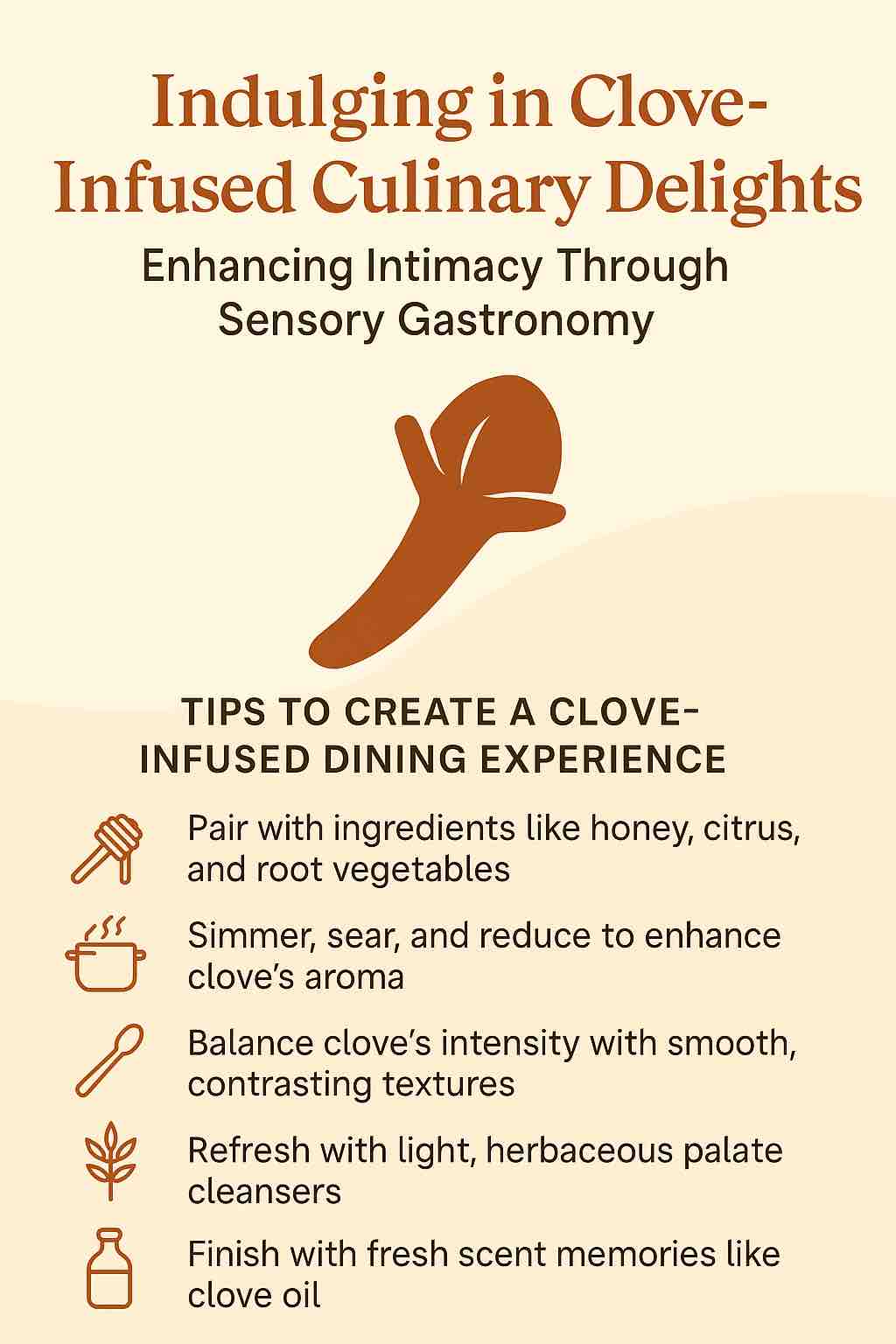
In an age where the dinner table often doubles as a desk and meals are hurried rituals between meetings, the art of eating has become disconnected from the sensory symphony it once was. But imagine a meal that goes beyond mere nourishment—a dining experience so thoughtfully crafted that it awakens every sense, evokes memory, teases desire, and deepens emotional connection. Welcome to the realm of sensory gastronomy, and at its aromatic heart lies a spice that has seduced palates for centuries: clove.
The Intimate Allure of Clove: A Spice of Desire and Depth
Cloaked in mystery, sharp yet sweet, clove carries with it a scent that lingers like a whispered secret. It is the dried flower bud of the Syzygium aromaticum tree, native to Indonesia, and its name derives from the Latin clavus, meaning “nail”—an apt description of its physical form. But beneath its humble appearance lies a history rich in sensuality, ritual, and healing.
In both Ayurvedic and Chinese medicine, clove has long been hailed as a stimulant for circulation and energy—both vital to enhancing physical intimacy. In ancient Arab cultures, it was ground into aphrodisiac potions. And in medieval Europe, clove was one of the rare spices that nobles treasured for its warmth, scent, and ability to mask undesirable odors—making it both a culinary and cosmetic luxury.
The clove’s active compound, eugenol, is not just responsible for its pungent scent and numbing effect—it also stimulates the senses, opens the sinuses, and sparks a warm sensation on the palate. In this way, clove doesn’t just season your dish; it primes your body for pleasure.
The Power of Sensory Gastronomy in Romantic Connection
True intimacy is multi-sensory. Touch, scent, taste, sound, sight—they all play a role in attraction and connection. Sensory gastronomy is a culinary philosophy that acknowledges this, creating meals that are not just eaten but experienced.
Shared dining, when stripped of distraction and infused with intention, becomes a kind of edible foreplay. It is conversation without words, trust through texture, and desire expressed through flavor. And clove, with its intoxicating scent and ability to enhance both sweet and savory, becomes a conduit for this exchange.
Science supports this. The olfactory bulb, responsible for processing smell, is directly linked to the brain’s limbic system—the seat of emotion and memory. That means a whiff of clove can trigger not only nostalgia or comfort, but also desire, if woven into a memorable intimate experience.
Crafting a Clove-Infused Dining Experience
So, how does one create an evening where food and intimacy intertwine? It starts with intention. Choose ingredients that complement clove’s profile—deep reds, earthy browns, golden honeys, citrus zests—and build a menu that tells a sensory story.
Here is a curated, clove-centric culinary journey, designed for emotional resonance and romantic indulgence.
1. Prelude: Scent & Sip
Clove and Orange Mulled Wine
Let the evening begin with a warm, spiced aroma filling the room. Simmer red wine with whole cloves, cinnamon, orange zest, and a splash of brandy. Serve in warm mugs with a sliver of orange peel.
🟤 Why it works: Heat amplifies clove’s aroma, inviting the guest into the experience gently but seductively.
2. First Course: Touch & Taste
Seared Scallops with Clove-Infused Brown Butter
Delicate scallops seared to golden perfection, served with a drizzle of brown butter infused with toasted cloves and a whisper of lemon. Plate over silky parsnip purée.
🟤 Why it works: The smooth texture of scallops against the nutty, aromatic richness of clove butter engages both palate and mouthfeel, sparking sensual anticipation.
3. Main Course: Depth & Desire
Spiced Duck Breast with Clove-Port Reduction
Succulent duck breast, slow-cooked and served with a port wine reduction that’s simmered with cloves, star anise, and blackberries. Pair with roasted root vegetables glazed with clove-infused honey.
🟤 Why it works: Duck’s richness stands up to clove’s intensity, while the port and berry reduction adds luxurious sweetness. This is a dish of complexity, patience, and payoff—like intimacy itself.
4. Interlude: Cleanse & Contrast
Clove-Lemongrass Sorbet
A light palate cleanser that balances the spice of clove with the bright freshness of lemongrass and a touch of mint.
🟤 Why it works: Keeps the sensory experience dynamic—preventing palate fatigue and refreshing anticipation for the finale.
5. Dessert: Sweetness & Seduction
Clove and Orange Crème Brûlée
A silky custard infused with orange zest and crushed cloves, topped with caramelized sugar for a shattering, sensual crunch.
🟤 Why it works: This dessert balances warmth and brightness, softness and crackle—mirroring the balance of intimacy: comfort and thrill.
6. Finale: Shared Scent Memory
Warm Towels Steamed with Clove Oil
End the meal with a ritual: warm towels lightly scented with clove and rosewater, offered for the hands. A small gesture of tactile care.
🟤 Why it works: This completes the sensory cycle, grounding the experience in scent and touch.
Sensuality Is a Shared Practice
The beauty of clove is that it refuses to be background noise. It demands presence. And when integrated into a meal with care and purpose, it becomes an aromatic catalyst for deeper connection.
Sensory gastronomy is not just about ingredients—it’s about intention. It’s about tuning into each other and into the meal as a mutual, immersive act. Clove becomes the thread that ties sensation to emotion, plate to palate, and heart to heart.
So next time you cook, don’t just ask “Does it taste good?”—ask “What does it feel like?”, “What does it awaken?”, “What memory does it stir?”
You may find that with a single spice, a table transforms into a sanctuary of shared indulgence and deepening intimacy.
FAQs
1. Why is clove considered an aphrodisiac?
Clove contains eugenol, which improves blood circulation and creates a warming sensation that can enhance physical sensitivity. Its potent aroma is also emotionally stimulating, often associated with comfort, warmth, and sensuality across various cultures.
2. Can clove be used in both sweet and savory dishes?
Absolutely. Clove’s spicy-sweet complexity works beautifully in savory dishes like duck, lamb, and stews, as well as in sweet treats like crème brûlée, mulled wine, and baked fruits.
3. What’s the best way to infuse clove flavor without overpowering a dish?
Use whole cloves when infusing sauces or liquids and remove them before serving. For subtler flavor, steep in warm liquids or oils for a short time, or use ground clove sparingly in spice blends.
4. How can I create a romantic dining atmosphere at home using clove?
Use clove-scented candles, simmer whole cloves in water on the stove before your meal, or add clove oil to warm towels or napkins. Pair the aroma with dim lighting and soft music to enhance the multisensory experience.
5. Are there any dietary considerations or allergies with clove use?
While rare, clove can cause allergic reactions in sensitive individuals. It’s also quite strong, so people with gastrointestinal issues or on blood thinners should use it cautiously or consult a doctor.
6. Can I substitute cloves with another spice?
Clove has a very unique profile, but for certain applications, you might substitute with allspice, cinnamon, or nutmeg—though none provide the exact same aromatic warmth or intensity.
7. How do I pair wine or cocktails with clove-infused dishes?
Rich red wines (like Syrah or Zinfandel) complement clove’s depth. For cocktails, opt for spiced old fashioneds, mulled wine, or dark rum-based drinks with orange and vanilla notes.
8. What’s the shelf life of whole cloves, and how should they be stored?
Whole cloves can last up to 2–3 years when stored in an airtight container in a cool, dark place. Ground cloves lose potency more quickly and should be used within 6–12 months.
9. How can I use clove for a non-culinary sensory element during a dinner?
Steam hand towels with clove oil for post-meal refreshment, use clove oil in an essential oil diffuser, or create a simple simmer pot with clove, orange peel, and cinnamon to scent the room.
10. What makes sensory gastronomy different from regular dining?
Sensory gastronomy involves intentionally engaging all five senses—taste, smell, touch, sight, and sound—to create a richer emotional and physical experience during meals. It’s about transforming food into an immersive ritual that fosters connection and intimacy.










